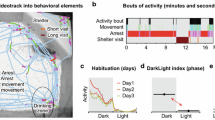Abstract
Most mixed strain progeny from gene-knockout experiments typically originate from C57BL/6J and one of the 129 substrains, frequently 129S6/SvEvTac. The results of this behavioral survey suggest that C57BL/6J:129S6/SvEvTac mixed strain mice are amenable to behavioral testing. The variability in behavioral tasks for subjects arising from this mixed strain genetic background does not preclude screening with a battery of behavioral tests. With clues provided by a screen of mixed strain subjects, follow-up analyses with isogenic, congenic, or F1 hybrid animals may be targeted to specific behavioral themes.
Similar content being viewed by others
References
Altman DG and Bland JM (1995) Statistics notes: the normal distribution. BMJ 310: 298.
Altman DG and Bland JM (1996) Detecting skewness from summary information. BMJ 313: 1200.
Anonymous (1997) Mutant mice and neuroscience: recommendations concerning genetic background. Banbury conference on genetic background in mice. Neuron 19: 755–759.
Bland JM and Altman DG (1996) Transforming data. BMJ 312: 770.
Cohen J (1988) Statistical Power Analysis for the Behavioral Sciences, Academic Press, New York.
Cohen J (1992) A power primer. Psychol Bull 112: 155–159.
Crabbe JC, Wahlsten D and Dudek BC (1999) Genetics of mouse behavior: interactions with laboratory environment. Science 284: 1670–1672.
Crawley JN (1996) Unusual behavioral phenotypes of inbred mouse strains. Trends Neurosci 19: 181–182.
Crawley JN, Belknap JK, Collins A, Crabbe JC, Frankel W, Henderson N et al. (1997) Behavioral phenotypes of inbred mouse strains: implications and recommendations for molecular studies. Psychopharmacology 132: 107–124.
Crawley JN and Paylor R (1997) A proposed test battery and constellations of specific behavioral paradigms to investigate the behavioral phenotypes of transgenic and knockout mice. Horm Behav 31: 197–211.
Crusio WE (1996) Gene-targeting studies: new methods, old problems Trends Neurosci 19: 186–187.
Denenberg VH (1984) Some statistical and experimental considerations in the use of the analysis-of-variance procedure. Am J Physiol 246: R403–408.
Denenberg VH (1996) A primer for behavioral research. Ment Retard Dev Disab Res Rev 2: 209–215.
Estill SJ and Garcia JA (2000) A marker assisted selection protocol (MASP) to generate C57BL/6J or 129S6/SvEvTac speed congenic or consomic strains. Genesis 28: 164–166.
Florey CD (1993) Sample size for beginners. BMJ 306: 1181–1184.
Fordyce DE and Wehner JM (1993) Effects of aging on spatial learning and hippocampal protein kinase C in mice. Neurobiol Aging 14: 309–317.
Garcia JA, Zhang D, Estill SJ, Michnoff C, Rutter J, Reick M et al. (2000) Impaired cued and contextual memory in NPAS2-deficient mice. Science 288: 2226–2230.
Gerlai R (1996) Gene-targeting studies of mammalian behavior: is it the mutation or the background genotype? Trends Neurosci 19: 177–181.
Hyde JS (1973) Genetic homeostasis and behavior: analysis, data, and theory. Behav Genet 3: 233–245.
Lathe R (1996) Mice, gene targeting and behaviour: more than just genetic background. Trends Neurosci 19: 183–186.
Logue SF, Owen EH, Rasmussen DL and Wehner JM (1997) Assessment of locomotor activity, acoustic and tactile startle, and prepulse inhibition of startle in inbred mouse strains and F1 hybrids: implications of genetic background for single gene and quantitative trait loci analyses. Neuroscience 80: 1075–1086.
Markel P, Shu P, Ebeling C, Carlson GA, Nagle DL, Smutko JS et al. (1997) Theoretical and empirical issues for marker-assisted breeding of congenic mouse strains. Nature Genet 17: 280–284.
Nelson RJ and Young KA (1998) Behavior in mice with targeted disruption of single genes. Neurosci Biobehav Rev 22: 453–462.
Owen EH, Logue SF, Rasmussen DL and Wehner JM (1997) Assessment of learning by the Morris water task and fear conditioning in inbred mouse strains and F1 hybrids: implications of genetic background for single gene mutations and quantitative trait loci analyses. Neuroscience 80: 1087–1099.
Palmer AR and Strobeck C (1986) Fluctuating asymmetry: measurement, analysis, patterns. Annu Rev Ecol Syst 17: 391–421.
Paylor R and Crawley JN (1997) Inbred strain differences in prepulse inhibition of the mouse startle response. Psychopharmacology 132: 169–180.
Roubertoux PL, Nosten-Bertrand M and Carlier M (1990) Additive and interactive effects between genotype and maternal environments, concept and facts. Adv Stud Behav 19: 205–247.
Roubertoux PL, Nosten-Betrand M, Cohen-Salmon C and l'Hotellier L (1992) Behavioral Development: A Tool for Genetic Analysis in Mice. Elsevier Science Publishers.
Upchurch M, Pounder JI and Wehner JM (1988) Heterosis and resistance to DFP effects on spatial learning in C57BL X DBA hybrids. Brain Res Bull 21: 499–503.
Upchurch M and Wehner JM (1989) Inheritance of spatial learning ability in inbred mice: a classical genetic analysis. Behav Neurosci 103: 1251–1258.
Wahlsten D (1991) Sample size to detect a planned contrast and a one degree-of-freedom interaction effect. Psychol Bull 39: 47.
Wahlsten D (1999) Planning genetic experiments: power and sample size. In: Jones BC and Mormede P (eds) Neurobehavioral Genetics: Methods and Applications. CRC Press, Boca Raton, pp. 31–42.
Wakeland E, Morel L, Achey K, Yui M and Longmate J (1997) Speed congenics: a classic technique in the fast lane (relatively speaking). Immunol Today 18: 472–477.
Wehner JM, Bowers BJ and Paylor R (1996) The use of null mutant mice to study complex learning and memory processes. Behav Genet 26: 301–312.
Wehner JM and Silva AS (1996) Importance of strain differences in evaluations of learning and memory processes mutants, Ment Retar Dev Disab Res Rev 2: 243–248.
Wolfer DP, Muller U, Stagliar M and Lipp HP (1997) Assessing the effects of the 129/Sv genetic background on swimming navigation learning in transgenic mutants: a study using mice with a modified beta-amyloid precursor protein gene. Brain Res 771: 1–13.
Zhou YD, Barnard M, Tian H, Li X, Ring HZ, Francke U et al. (1997) Molecular characterization of two mammalian bHLHPAS domain proteins selectively expressed in the central nervous system. Proc Natl Acad Sci USA 94: 713–718.
Author information
Authors and Affiliations
Rights and permissions
About this article
Cite this article
Estill, S.J., Fay, K. & Garcia, J.A. Statistical Parameters in Behavioral Tasks and Implications for Sample Size of C57BL/6J:129S6/SvEvTac Mixed Strain Mice. Transgenic Res 10, 157–175 (2001). https://doi.org/10.1023/A:1008955016170
Issue Date:
DOI: https://doi.org/10.1023/A:1008955016170




